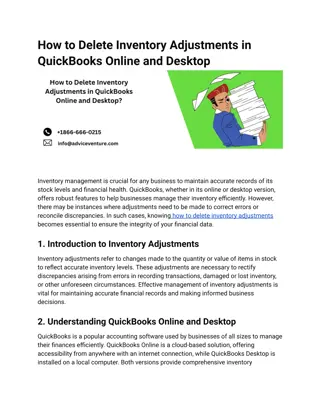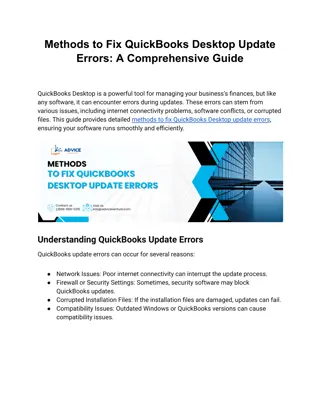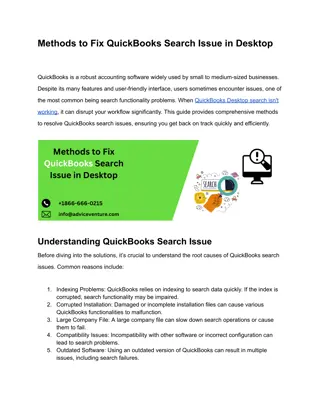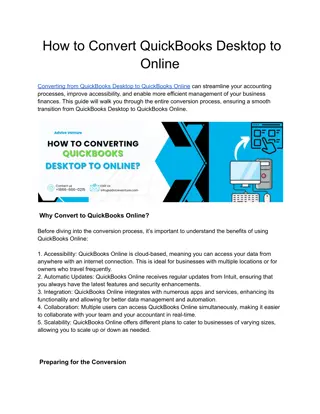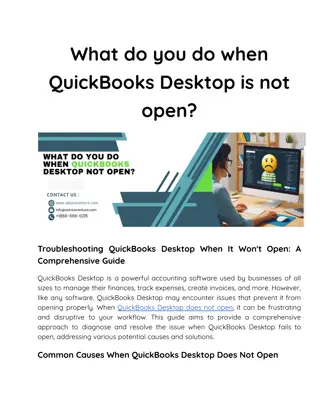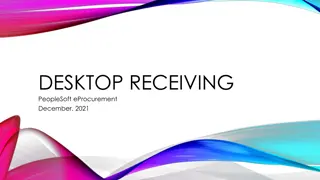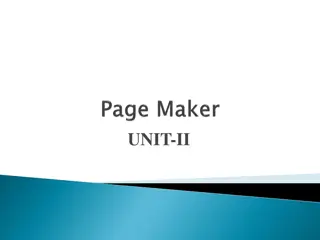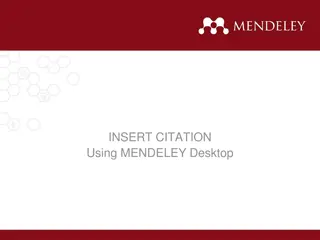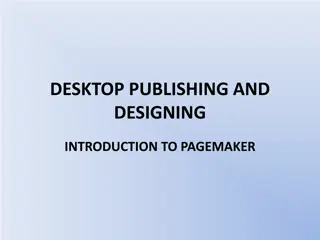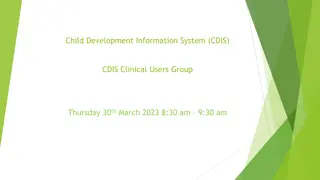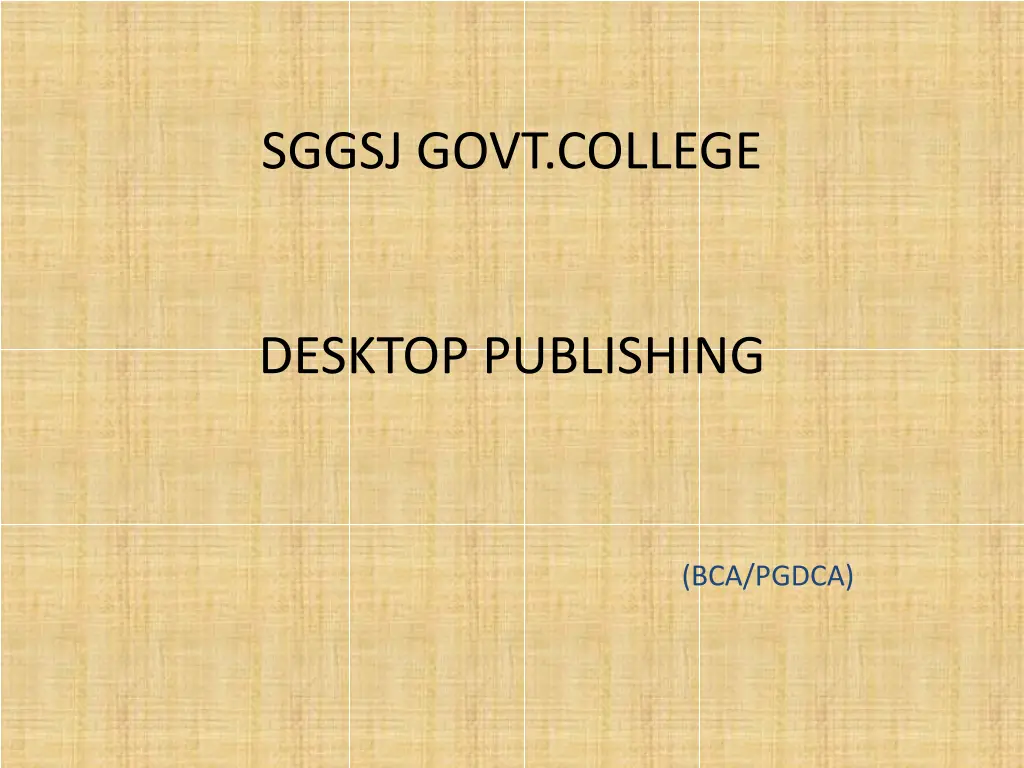
Understanding the Benefits of Desktop Publishing
Discover the importance of Desktop Publishing (DTP) in modern design, its advantages over word processing software, and how it facilitates the creation of various media types both in print and digital formats. Explore the enhanced appearance, increased productivity, easy customization, and cost-effective production that DTP tools offer to businesses and designers.
Download Presentation

Please find below an Image/Link to download the presentation.
The content on the website is provided AS IS for your information and personal use only. It may not be sold, licensed, or shared on other websites without obtaining consent from the author. If you encounter any issues during the download, it is possible that the publisher has removed the file from their server.
You are allowed to download the files provided on this website for personal or commercial use, subject to the condition that they are used lawfully. All files are the property of their respective owners.
The content on the website is provided AS IS for your information and personal use only. It may not be sold, licensed, or shared on other websites without obtaining consent from the author.
E N D
Presentation Transcript
SGGSJ GOVT.COLLEGE DESKTOP PUBLISHING (BCA/PGDCA)
DESKTOP PUBLISHING Desktop Publishing software (DTP) was originally created to design printed documents. Before DTP tools existed, the typesetting of printed documents was a little arduous, to say the least. With their advent, the design and creation of print media became a whole lot cheaper and easier. Since that time, the use of DTP has also expanded into the digital design space. It now encompasses everything from the design of infographics to website design.
NEED OF DTP Desktop Publishing packages are often used to produce physical media such as newspapers, magazines, marketing materials, point of sale displays, product packaging designs, business cards, and outdoor signs. In the digital space, they are used to create things like web pages, GUI (Graphical User Interfaces) and e-books. These days, companies use DTP packages over old-fashioned word processing software like Microsoft Word because they offer: Enhanced appearance for all produced documents Increased productivity Easy customisation of all kinds of projects Minimised production costs A way to manage presentation as well as content
ADVANTAGES OF DTP 1) Handles far more graphical elements than a word processor Word processing software certainly has its place. But Desktop Publishing software has taken over from it in almost any project where different fonts, pictures, layout and graphics are going to be involved. In fact, the more elements that are going to be included in a piece, the greater the advantages of using DTP software over a word processor. Projects which include a large number of graphics and pictures will particularly benefit. 2) Frame-based A sizeable part of the advantages of Desktop Publishing packages, even the basic Microsoft Publisher, is that they are frame-based. This means that frames of text or images can be moved over, around and on top of one another and rescaled with ease. The ability to easily move frames around to view their impact when placed in a different layout or with different spacing really comes into its own when DTP software is used to create projects like magazines and newspapers.
ADVANTAGES OF DTP 3) Easy import Text and graphics can also be easily imported from outside sources. You can bring together disparate elements such as: Images from a scanner Frames shot by a digital video camera Text written in a word processor Graphics created using your favourite drawing software 4) WYSIWYG It means What You See Is What You Get. This acronym refers to the fact that, with DTP software, what you see on the screen will be what the final document looks like in printed form. If you ve ever created a project as a Word file and then printed it out only to discover a huge disparity between what it looked like on the screen and what it looks like in your hand, you ll understand why this is so important for professionals. This means that a page layout can be easily optimised and enhanced without needing to see it on paper. The WYSIWYG aspect of DTP puts professionals who use it well ahead of their counterparts struggling to cut and paste elements using a word processor.
ADVANTAGES OF DTP 5) Automatic restructuring Many DTP software packages can be set to automatically restructure other elements around a frame which has been moved. Want to see if a snapshot looks better in the corner of a paragraph with the text wrapped around it? No problem. Doesn t look good in the new position? Reverse the change. You can also set text to flow under a frame or have it keep a set space from a frame boundary, or have an image positioned uniquely within a frame. This gives you a great deal of flexibility in the final appearance of a document or page. Marketing materials such as brochures, flyers and catalogues, in particular, hugely benefit from the use of DTP tools in their creation. Because these tools offer an easy way to adjust the spacing, colours and contrast of a document, its appeal can be edited or altered to meet the preferences of any given audience. 6) Work in columns, frames and pages Unlike most word processors, you can also easily create columns as well as frames and pages. Text will automatically snake (the technical term for flow) from one column to the next, again making DTP ideal for creating newspapers and magazines. Kerning is the technical term for editing the space between letters. Different fonts and even different pairs of letters require different spacing for comfortable reading. The best DTP software allows easy individual control over kerning so that larger headings and titles, as well as other text elements, can be perfectly aligned and adjusted for impact and readability.
DISADVANTAGES OF DTP 1) Expensive tools One of the main disadvantages of Desktop Publishing is the relative expense of the tools themselves. Many companies baulk at the costs of purchasing specialist software such as QuarkXpress or Adobe InDesign, Photoshop, FrameMaker or Illustrator. Outsourcing to professionals is frequently the way that a company will choose to overcome this problem.
DISADVANTAGES OF DTP 2) Lack of large scalability Another disadvantage of DTP is that it sometimes struggles with very large-scale, highly complex projects. That s because these projects frequently require paying attention to more than just the presentation and content of a project the two areas which DTP software handles so well in order to cover: The overall structure of a project, including things like section levels and connections between related documents in multiple projects Reusing content in other projects Keeping the different types of output a project requires consistent Online and offline storage and distribution In recent years though, many of the market-leading DTP tools have started to include these features in what they offer.
APPLICATIONS OF DTP Graphic Design. Professional graphic designers use DTP programs such as QuarkXPress, Adobe PageMaker, and Adobe Photoshop to create webpages, the front pages of newspapers, and a variety of other visual documentation. Without desktop publishing, there is no graphic design, and vice versa.
APPLICATIONS OF DTP Career Assistance. Microsoft Word and Open Office are used faithfully by numerous job seekers everyday as they work to put together the perfect resume, cover letter, or portfolio. Many create documents from scratch, while others take advantage of the oh-so-convenient templates.
APPLICATIONS OF DTP Education. In the education field, teachers and students use a variety of DTP programs to complete assignments and projects. Whether it s an Intro to Desktop Publishing course and the program of choice is QuarkXPress, or a Technical Writing Course that takes an in-depth look at Microsoft Word, the use of DTP in educational institutions is very prevalent. Business. Today, desktop publishing is pretty much used to handle all of the paperwork of a business. Although it s possible to run a business without the help of DTP, it isn t the smartest business decision. From sole-proprietorships to Fortune 500 companies, DTP software is a lifesaver and money saver. Examples of DTP use in businesses are business cards, legal documentation, and advertising materials.
APPLICATIONS OF DTP Crafts and Personal Projects. Desktop publishing is the crafter s dream come true. Across homes all over the world, parents are looking for easy, cheap, and fun crafts to create with their children, teachers need ideas for students, and the interior decorator could use an origami template.




